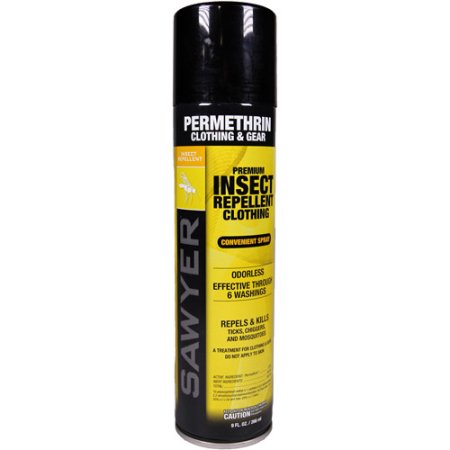Ticks are no laughing matter. Ask anyone who has acquired Lyme disease, Anaplasmosis, Rocky Mountain Spotted Fever, or any number of other tick-borne diseases, and they can give you a first-hand account on how such a tiny tick can inject humans with a serous and long-lasting illness. The fact is that ticks are responsible for the most vector-borne diseases in the USA, and it is not even close. The expansion of the deer tick (blacklegged tick) range in North America has only made the tick-borne illness risk greater.
Anytime I take a group of friends or family on a hike, or to spend a day in the wild, I remind them “the most dangerous animal out here is a tick.” That, despite being surrounded by bears, wolves, badgers, and other predatory animals. Ticks are for real, and if you are bitten by the wrong one, it could create long road of health problems.

Unfortunately, the very time we most like to be outside is also when ticks are the most active, creating a higher risk of getting bitten. Not only are tick bites annoying, but they can also be extremely dangerous to our health. From Lyme disease to the emerging Powassan virus, tick bites are nothing to take lightly.
The good news is that there are some repellents that are quite effective at keeping ticks away. An investment in some tick repellent is money well spent!
There are so many tick repellents available to choose from, figuring out which will be the best for you can be a daunting task. Some are going to be the same repellents you would use for mosquitoes (DEET repels ticks, too), while others are marketed largely for ticks. To make things easier, we’ve researched and analyzed several of them and put together the list of the best products on the market below.
The Best Tick Repellents (for Humans)
Our experience and research suggests that the best tick repellent isn’t a single answer at all — rather, it is a combination of two effective repellents. A “tick cocktail” of sorts. Use permethrin on clothing and footwear, and DEET on exposed skin. The overall recommendation? Don’t mess around with experiments or “maybe” repellents. Lyme disease is too serious to cut corners on. Go straight for the proven stuff, below.
By the way, these tick repellents are for humans. If you are looking for a tick repellent for your dog, check here.
OFF! Deep Woods Insect Repellent
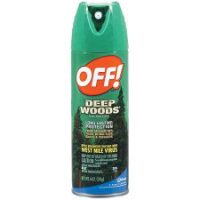 For exposed skin. This tick repellent has 25% DEET and will give you basic protection against both ticks and other insects such as mosquitoes, black flies, fleas, sand flies, gnats, chiggers, and many other ‘no-see-ums’. It doesn’t last for a very long time and according to the manual it’s highly recommended to reapply every few hours. You can apply it on bare skin as well as fabrics such as nylon, cotton, or wool. For enhanced tick protection, the manufacturer advises to also spray your socks, cuffs, and other areas around your outer clothing’s openings that bugs might sneak in. However, we like treating our clothing and footwear with permethrin as well.
For exposed skin. This tick repellent has 25% DEET and will give you basic protection against both ticks and other insects such as mosquitoes, black flies, fleas, sand flies, gnats, chiggers, and many other ‘no-see-ums’. It doesn’t last for a very long time and according to the manual it’s highly recommended to reapply every few hours. You can apply it on bare skin as well as fabrics such as nylon, cotton, or wool. For enhanced tick protection, the manufacturer advises to also spray your socks, cuffs, and other areas around your outer clothing’s openings that bugs might sneak in. However, we like treating our clothing and footwear with permethrin as well.
If you live in a buggy climate, it is a good idea to keep DEET around the same way you might keep spare change or an extra pair of sunglasses. At any given time, I keep a can of DEET in my car, my entryway, my garage, just about everywhere. It is just as much a repellent for mosquitoes as it is for ticks.
Studies we have researched suggest that you want at least 20% DEET in your repellent in order for it to be effective, so this one at 25% (and the next at 40%) fit that criteria.
OFF Deep Woods is a classic aerosol spray, synonymous with the outdoors, and is easy to use and its advise for the best spread to apply it in a continuous sweeping motion. We like it because of its multi-purpose nature, and the fact that the bottle tends to travel well in backpacks, etc, without having mis-sprays. The only thing we would note is that if you are in a uniquely heavy tick area, you may want to go for the permethrin as well — and we get to that a little later. Find here on Amazon.
Pros
- Many choices of DEET concentration levels
- Easy to find
- Good on the skin
Cons
- Doesn’t work as well on clothing
- Need to re-apply often
Repel Sportsmen Max Insect Repellent 40-Percent DEET
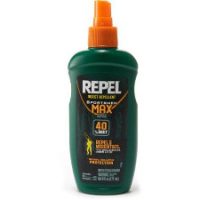 Also for exposed skin. This one has more DEET in it (40%) and is one of the best sellers in the tick repellent category. More DEET gives you a longer-lasting application.
Also for exposed skin. This one has more DEET in it (40%) and is one of the best sellers in the tick repellent category. More DEET gives you a longer-lasting application.
Once applied, the 40% DEET concoction is effective for up to 8 hours and besides ticks, it keeps fleas, mosquitoes, chiggers, gnats, and biting flies far away from you, your family and friends. It is recommend that you apply this product only on body parts that are uncovered. Of course, you can also spray it on fabric, but then you are left with the smell in your clothing for perhaps little benefit. Another thing to keep in mind is not to use it right after you’ve showered; wait a little while until you apply it in order to avoid irritation.
The 40% solution (versus the 20-25% that is common) of DEET simply means that it will last longer than a lower-concentration product, providing protection for a longer period of time. Find it here on Amazon.
If you need a little extra boost or duration from your repellent, we also like Repel 100, a similar product but with a higher concentration of DEET.
Pros:
- Very effective when applied to skin
- Also keeps the mosquitoes away
Cons:
- Wears off of clothing quickly
- Need to re-apply often
Sawyer Products Permethrin for Clothing and Gear
Now for the permethrin, the best choice for clothing, footwear, and gear protection against ticks. We always have the distinctive yellow can of permethrin within view when we are headed to an area known for heavy deer tick penetration.
Sawyer Products makes perhaps our favorite spray for serious tick areas, using permethrin which is a highly-effective tick repellent. It also works on mosquitoes, so you get a bonus. We recommend this if you are going into an area known to be infested with deer ticks or other ticks, because in those areas you do not want to cut any corners — protect yourself from the ticks. The main thing to 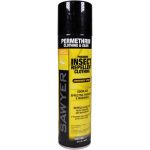 know about the permethrin solutions is that they are not intended to be used to skin. Spray them on your boots, clothing, and gear, but we advise keeping your skin free of the chemical. DEET is better for skin. It is not necessarily that permethrin is a danger on skin, but it breaks down very quickly on skin.
know about the permethrin solutions is that they are not intended to be used to skin. Spray them on your boots, clothing, and gear, but we advise keeping your skin free of the chemical. DEET is better for skin. It is not necessarily that permethrin is a danger on skin, but it breaks down very quickly on skin.
Basically, spray the permethrin on any outerwear that will be in contact with the ground, grass, and brush.
The distinctive yellow Sawyer can is a nice touch. I recognize it from afar if I am in the field, hunting, or working outside. Every time I plan to be outdoors for a day, I reach for it and touch-up my footwear and the bottom of my pants, even though it says it works for multiple wears.
Sawyer also makes a 24 ounce pump spray bottle, with the same permethrin chemical, which is a little large to carry along on a hike, but great to keep in your vehicle if you find yourself in tick areas on regular occasion.
We think this is an essential spray to have along if you are headed to ground zero of Lyme disease country, or the home to any number of other tick-borne illnesses. Use it on your boots, pantleg, and other gear. Find here on Amazon.
Pros:
- It works. What more can we say?
- Keeps for a long time
- Do not need to re-apply often
Cons:
- Not for use on skin. Clothing and footwear only.
- Need to combine with DEET for the skin
Permethrin vs. DEET?
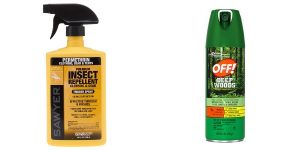
Permethrin and DEET are both effective in repelling ticks, but for different reasons and with different uses. We did a separate comparison of DEET vs. Permethrin vs. Picaridin, but we will summarize it all here.
Permethrin (not to be confused with the common mosquito repellent, picaridin) is a true insecticide that can repel, damage, or even kill small bugs. Humans can break down the chemical much easier, which is why we can use it but it is so effective on bugs. Still, it is not recommended you use permethrin on skin. That is why permethrin is best for applying to footwear, clothing, or gear to repel ticks. The only place we try to be careful about applying permethrin to clothing is when we will be in contact with lakes or streams, as permethrin may be toxic to fish (attention fly fishermen).
DEET, on the other hand, is best known for use against mosquitoes. DEET is gentler, so to speak, because it never kills or really hurts insects. Rather, it confuses their sense of smell so they have a hard time locating us. DEET is OK to use on the skin.
Historically, they are quite different compounds too. While pyrethroids have been around for decades, permethrin specifically has been in use since the late 70s. It actually comes from the chrysanthemum flower. DEET, on the other hand, was developed in the 1940s for WWII jungle warfare, and worked so well that it became mainstream after more testing and refinement.
The Ideal Combination: Permethrin + DEET
We recommend using both permethrin and DEET in tick-heavy areas. Permethrin on clothes and footwear, DEET on exposed skin. This is the combination we have settled on after years in heavy tick areas, spending time in long grass and brush…. in other words, ideal tick habitat. We find that the blend of DEET on the skin and permethrin on clothing and footwear is the perfect 1-2 punch.
While permethrin — unlike DEET — is not intended to be something you do not have to apply every single time you are headed outside, it should be reapplied every few outings.Note that after 5 washings, it is recommended that you reapply Permethrin to your clothing. If you want to err on the safe side, apply it more frequently.
We are all ears for a better concoction that is safe and based on scientific studies, but until we find one, this is our go-to.
Using Tick Repellents Wisely
First things first, let’s take a look at what makes these products work. Ingredient-wise, DEET and Permethrin are the approved active substances found in most tick repellents. They are both efficient in keeping insects away without damaging your health (based on testing done to-date). However, If you want to go for a more natural repellent, organic ingredients such as geranium, catnip, lemon eucalyptus, and citronella oils have been shown to keep ticks away to lesser but still effective extent. When in doubt, we would go straight for the DEET or Permethrin, though. We would never want to advise you to experiment with something that was not effective in the field.
You need more DEET to keep ticks away than for typical mosquito protection. Keep that in mind.
Permethrin generally seems to be more effective at keeping ticks away than the more classic bug repellents like DEET, but it is not meant for skin. Use on your boots, shoes, socks, and pants for best results.
DEET, on the other hand, is approved for use directly on skin. While some DEET is absorbed through the skin, it tends to be a very small amount. Using DEET along with sunscreen, and while drinking alcohol, may increase the amount that is absorbed. The research is still evolving, but there is enough evidence to suggest that you should be careful when mixing DEET and topicals like sunscreen, or DEET and alcohol.
When choosing the tick repellent for you and your family, you must consider the concentration of the active ingredient found in the products. You’ll find various repellents have different concentrations of DEET, for example: from as little as 10% to as much as 98%. These numbers don’t actually indicate the protection’s effectiveness; they indicate the amount of time until you need to reapply the product. Products with low percentages are effective for perhaps a couple of hours, while others with higher percentages can keep ticks away for up to 12 hours. However, some studies have shown that you want to use at least 25% DEET solutions for the best results against ticks, but they should be reapplied every 4 hours or so. Mosquitoes are a different story — they can be kept at bay with small amounts of DEET.
For the majority of adults, a percentage of 25% to 30% of DEET offers suitable protection. Of course, it depends on how much an individual sweats, if he or she has been out in the rain, swimming in a pool, and so on.
In order to apply your repellent efficiently, follow the instructions written on the repellent’s package. For most children, the recommended maximum percentage is usually 30%. Keep in mind that the American Academy of Pediatrics doesn’t recommend using any type of repellent on infants who are younger than 2 months.
Don’t forget to reapply. Repellents wear off after a while, and their effectiveness is best just following application. Reapplication tends to be more important for ticks than for mosquitoes. 4 hours tends to be the maximum amount of time to go without re-applying.
Keeping ticks away is definitely not a mission impossible. With a great tick repellent and following the recommendations we discussed above, you’ll be able to fully enjoy the warm weather and the outdoors without earning any nasty tick bites.
Even if you have been using the combination of permethrin and DEET, you should always check yourself for ticks after being outside in a tick area. It just takes one tick to hitch a ride on your clothing or skin, and you could be bitten.
Tick Repellent FAQs
Children and DEET – Is it a safe combination?
Note that when it comes to children and DEET, the American Academy of Pediatrics has issued some guidelines to follow. Children over the age of two should use a maximum of 33% DEET. DEET is not recommended for children under the age of two.
When and where should I use tick repellent?
Ticks can be active during much more of the year than people assume. The typical range for activity is between March and November, with heightened tick activity in the spring and fall. However, ticks can really be active on any day when the temperature is above freezing. They can be found in nearly any environment including yards and parks, but we find them most often in areas with longer grass, brush, and trees. Definitely take precautions if you will be camping, hiking, or exploring nature in a known tick area (which is expanding each year).
How about completely natural repellents? Do they exist?
There is some evidence that natural oils such as geranium oil, lavender oil, and garlic oil may have tick-repelling properties. Such oils are often sold as essential oils, and we did an entire piece on using essential oils as tick repellents. While they are worth a try, we like to follow the hard science. Permethrin is the most effective protection against ticks, and a permetherin-DEET combo seems particularly useful. Lyme disease is nothing to flirt with, so we suggest following the hard science as well. But if you want to give essential oils a try, it is your call. Some relatively recent studies have found encouraging results, and certain oils seem to have some degree of effectiveness in certain situations. We welcome any reader input that would point us to essential oil / tick studies that we perhaps are not aware of.
using essential oils as tick repellents. While they are worth a try, we like to follow the hard science. Permethrin is the most effective protection against ticks, and a permetherin-DEET combo seems particularly useful. Lyme disease is nothing to flirt with, so we suggest following the hard science as well. But if you want to give essential oils a try, it is your call. Some relatively recent studies have found encouraging results, and certain oils seem to have some degree of effectiveness in certain situations. We welcome any reader input that would point us to essential oil / tick studies that we perhaps are not aware of.
Will there ever be a Lyme disease vaccine?
We at the Tick and Mosquito Project think there someday will be a Lyme disease vaccine that is safe for humans, but our guess is that it will not be ready to use for a decade or so. There was a vaccine that was tested back in the 90s and showed some good promise, but the side effects were too common and troubling, so the product was shelved.
There are efforts again to create a vaccine that will work in humans (dogs can already be vaccinated) and they look encouraging. However, given the time required for regulatory approval, testing, and production and marketing of the product, it might be 5-10 years before doctors are willing and able to vaccinate you for Lyme disease — and that assumes that the testing all goes very well. Until then, you need to keep the ticks away from you. Actually, even when the vaccines are available, you will probably want to keep the ticks away because of all the other emerging disease they carry.
Does Tick Repellent Work?
Perhaps the question you are really curious about is if tick repellent really works. Yes, the repellents we have listed above work. They work in a lab, as evidenced by the EPA and other agencies.
Anecdotally (and we are talking about a compelling pattern of anecdotes in heavy tick areas), the combination of permethrin on the clothing and footwear and DEET on the tick greatly reduces the number of ticks you will find on you at the end of the day. Don’t take chances, use repellents.
Written by Tick and Mosquito Project Staff. Most recently reviewed by Nicole Chinnici, Northeast Wildlife DNA Laboratory Director at East Stroudsburg University

